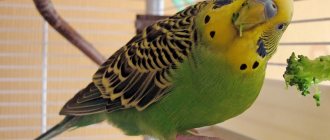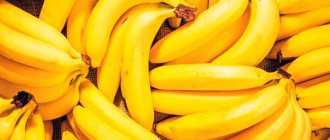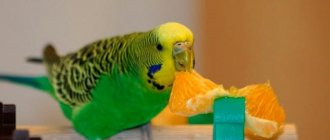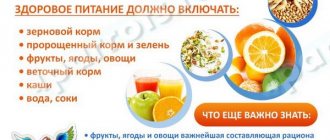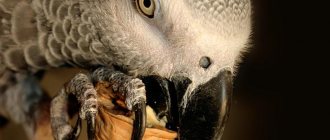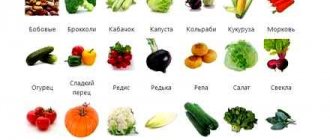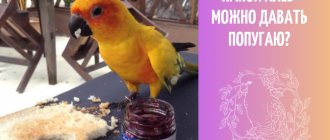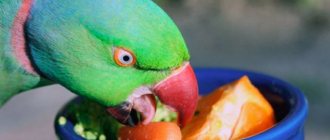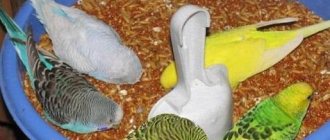Under natural conditions, parrots eat a variety of foods. They get complex carbohydrates from grains that they find in fields and forests. Vitamins and essential microelements - from greens, vegetables and fruits. Birds can also use watery fruits and vegetables to replenish their body fluids. However, not all breeders feed parrots so variedly. Some do not consider it necessary to introduce anything other than grain into their pet’s diet, others simply do not know what else is allowed to feed birds. We will tell you in more detail about what fruits parrots can eat and how often they should be given.
But first, let's talk about how to serve these fruits. First of all, they need to be washed thoroughly. Since most fruits sold in markets and stores are coated with wax, it is better to wash them using a special product. Then it is advisable to cut them into medium-sized pieces so that it is convenient for the bird to eat them.
What fruits can you give your parrot?
The list of permitted fruits includes apples and pears. They can be found in all regions of Russia at almost any time of the year. Parrots like all types of these fruits. When serving, it is advisable to remove the seeds and remove the stalks. Citrus birds can be pampered with oranges, grapefruits and lemons. Before you cut the fruit, peel it. It is better not to give the hard crust to birds.
When talking about what fruits parrots can eat, we cannot fail to mention bananas. Their exotic birds are most often eaten in natural conditions. In the wild, birds choose only ripe fruits, so you should feed your pet fruits with bright yellow skin. By the way, it must be removed so that the bird can enjoy the soft and nutritious filling.
Another exotic fruit that parrots are allowed to eat is pineapple. In the wild, birds have to work hard to get to the juicy and sweet pulp. If you don't want the bird to splash juice on the walls and floor while peeling, peel the fruit yourself. And treat her with pieces of pineapple pulp.
Often inexperienced breeders ask about what fruits parrots like. Everything here is individual. Some birds prefer citrus fruits, others are delighted with plums, and others may be indifferent to fruits altogether. If the breeder from whom you purchased the bird did not tell you about your pet’s preferences, you can only find out about them by experimenting. Treat your bird to different fruits and you will soon understand which ones he likes best.
Answering the question “what fruits can be given to a parrot,” we will also mention kiwi. This sour fruit is not to the taste of all birds, but some birds eat it with pleasure. By the way, it is kiwi that allows the parrot to replenish vitamin C reserves and improve immunity, so you should not neglect it. It is better to remove the thin, rough film from the surface of the fruit before serving.
Can birds eat clay?
Budgerigars should always be provided with enough clay for their needs, as clay absorbs all toxins and removes them from the body. Despite the high level of development of medicine, the role of clay in metabolism has not yet been established.
Budgerigars living outside the wild and experiencing a clay deficiency may subsequently produce offspring suffering from rickets. There are a large number of assumptions about why birds in the wild try to extract clay for themselves in their favorite ways, so it is better to take this as a given, which is beyond doubt.
There is a myth that is very common among bird owners that fruit seeds are a source of toxic effects on the bird’s body. The seeds contain a huge amount of fat and protein, which is already an ideal platform for the development and reproduction of mold fungi. Therefore, first of all, you need to adhere to the rules for storing such products. They should be stored in a dry, cool and dark place.
Before giving the seeds to parrots, you should break a few grains to make sure that the product has not spoiled. Every summer you should make supplies for the winter; you do not need to store such a product for more than 12 months.
What fruits can parrots eat in small quantities?
Unfortunately, not all fruits are well accepted by the body of birds. Some may negatively affect digestion. Treats that birds can eat in strictly limited quantities include watermelons and melons. These fruits can be given only in season and in small portions. Moreover, preference should be given to ripe fruits. Unripe fruits can cause digestive problems.
What fruits can be given to a parrot in small portions? Prunes, raisins, dates and dried apricots. Moreover, before serving, they must be washed to remove dirt and steamed well. Since dried fruits are very high in calories, your parrot should not be given more than a few fruits per day. If you wish, you can mix several types of fruits and serve them as a vitamin salad.
When talking about what fruits a parrot can eat, we need to remember apricots, plums and peaches. Most birds like these fruits because they are soft and juicy. In the wild, birds often use them to replenish their body's moisture reserves if they cannot find clean water to drink. You should not give your parrot whole fruits, as he will most likely try to taste the pit. And it contains hydrocyanic acid, which is very harmful to birds.
Berries for the parrot
Parrots can eat not only fruits - they love to feast on berries. Make sure you always have fresh, dried or frozen fruits in stock:
- Rowan;
- currant;
- irga;
- rose hip;
- honeysuckle;
- raspberries;
- gooseberry;
- chokeberry.
At the beginning of summer comes the season of fragrant strawberries. It contains vitamin C and antioxidants, so its benefits are undeniable. The answer to the question whether a parrot can eat strawberries is only positive if the amount of nitrates does not exceed the norm.
The gifts of the swamp are tasty and healthy: cranberries, lingonberries, blueberries, cloudberries. Birds often peck at the berries, getting to the seeds - their favorite food.
Attention! Small parrots may choke on round berries while trying to swallow them whole. The treat must be crushed to protect the pet from death.
Frozen berries retain all the vitamins, so this method of preparation is best suited. You should not pour berries into the feeder straight from the freezer; let them melt, otherwise the bird will catch a cold. You can make compote without sugar from dry berries. Fruit and berry seeds are not garbage, they are needed for training and strengthening the beak. Birds have fun by chewing shells with their beaks.
How to accustom a parrot to fruit?
If you adopted a bird at a young age, when he had not yet tried anything other than grain, try to more often add not only bananas and pineapples, but also kiwis, plums, apples, pears and other fruits to his menu. Serve them in different forms: finely chop them, mix them into salads, turn them into a paste, or string them onto twigs. The main thing is not to give up trying to diversify your bird’s diet.
If your bird is reluctant to try fruit, try to get her interested by eating healthy fruit in front of her cage. You can also try bananas and apples when you let your bird fly. He will probably be interested in what you are eating, and he will want to try a piece.
Have you tried all the methods, but still can’t figure out how to train your parrot to eat fruit? Take advantage of the accessories and holders that pet stores offer. They have an original look and are very similar to the toys loved by birds. The appearance of a new, and even such an interesting object will interest the pet and force it to spend time studying it. During the examination, the parrot will find out that its new toy is edible and will try its first fruit.
What not to give
It is strictly forbidden to feed the nymph with the following products:
- mango, persimmon, bird cherry and papaya.
- potatoes, avocado, onions, garlic.
- green tops from tomatoes.
- spicy herbs.
- mushrooms.
- chocolates.
- milk, hard cheese, cream.
- freshly baked pastries and bread.
- human drinks: coffee, tea, alcohol, cocoa.
It is also not advisable to feed the bird from your table, because fried, fatty and salty foods will significantly shorten the life of your pet. Remember that the cockatiel does not eat everything; what is tasty and good for a person can turn into disaster for a bird.
Why does a bird refuse fruit?
There may be several explanations for this. Perhaps the bird is simply afraid to try unfamiliar food, since it has never seen anything like it before. Such fears worry both chicks and adults. If this is your case, offer your bird fruit more often. And before you give a piece to the bird, try it yourself. And so that the pet can see it.
A parrot may also refuse fruit because it was once treated to a spoiled or unripe fruit, after which it felt unwell or became completely ill. Such impressions are remembered in order to prevent the bird from eating food that is inappropriate for it. How to save a bird from an unpleasant experience? Replace it with a new one. Look for the fruit that the bird will perceive positively.
His childhood can tell you why a parrot doesn’t eat fruit. If you took a bird from a reseller or a pet store that sells rare birds, your pet probably entered the country illegally. Such birds are transported in terrible conditions and fed only to last until they are sold. Having become accustomed to a meager diet, usually limited to grain crops, the parrot cannot accept other food for a long time. However, this does not mean that attempts to accustom him to fruits should be abandoned. Continue to arouse interest in healthy food, and one day the bird will be tempted by the bright fruit.
A bird may also ignore fruit because it is sick. She may have gastrointestinal problems that prevent her from enjoying plant-based foods. If you notice a deterioration in your bird's appetite or problems with stool, contact your veterinarian.
You can ask an ornithologist about why your parrot does not eat fruit, if this specialist has been observing your pet since childhood. Perhaps you simply offer not the ripest and not the most delicious fruits?
Vegetable and fruit seeds are an integral part of the budgerigar’s diet.
As for the seeds from vegetables and fruits, they must be present in the diet of your feathered pet, because they contain a high concentration of vitamins and elements that budgerigars need. But the pulp of fresh vegetables and fruits is of little interest to the pet.
It is best to use foresight and stock up on a large number of cherries, sweet cherries, apples, pears, apricots, grapes and plum seeds in the summer. If you yourself are not able to collect a sufficient amount, then you should turn to friends for help, let them dry the seeds and give them away. In winter, pets will be grateful for such care!
By eating the bones, birds wear down their beaks. As a result, parrots, as a rule, no longer need to trim and trim their beaks, since this process occurs in a completely natural way.
Almonds are an incredibly beneficial element for all birds without exception. This is especially true for unripe almonds. When it comes to sweet and bitter almonds, budgies should get both.
Why does cockatiel eat a lot?
The amount of feed may depend on the bird's temperament. More active individuals eat more. Calm, sedentary parrots consume few calories, and therefore their need for food is less. However, it is important to remember that there is a limit to everything, because if a cockatiel parrot constantly eats in large quantities, then this is a reason to be wary.
If you limit the amount of food your parrot can eat, he may start eating in reserve because he will be afraid of the lack of food. Give food regularly in the right quantity, it is necessary that it is constantly available.
When solving the problem of why the cockatiel constantly eats, make sure that the nutritional value of the food corresponds to the age of the bird. This will ensure normal growth and development. If an adult bird is given food for small parrots, it will not have enough vitamins. This threatens the appearance of vitamin deficiency. Then the cockatiel eats a lot to compensate for the lack of vitamins and microelements.
Vegetable menu
Fresh vegetables are an integral part of a budgie's diet. Give what you need every day.
Let us explain what vegetables can be given to a budgie:
- cabbage - white cabbage, broccoli, Peking cabbage and other types of this family. Everything contains a lot of all kinds of useful components. It is beneficial for the stomach when consumed, stimulates metabolism and easily cleanses the body of waste and toxins;
- carrots – the root vegetable contains carotene, lysine, ascorbic and pantothenic acid. Promotes pet growth and good vision. One piece a day is enough;
- pumpkin - in addition to its aesthetic qualities, has many useful components. The pulp is saturated with all kinds of vitamins, magnesium, potassium, iron. Removes toxins and excess cholesterol;
- cucumber – a huge content of vitamin E. A rich community of minerals. Helps in the absorption of food and normalize metabolism;
- beets - occupies a leading position in the presence of useful components. It has antioxidants and many other useful minerals necessary for the life of a budgie. Provides a wide range of benefits to improve the functioning of the body.
- Tomato or tomato has obvious benefits for your pet; it is a powerful antioxidant. Is a source for the health of the parrot. Normalizes metabolism, prevents the appearance of fungal diseases.
What do wild parrots eat?
To find out what to feed your cockatiel at home, it is advisable to get acquainted with the menu of his brothers who are in the wild. The homeland of these wonderful birds is Australia. There they settle in steppes and forest-steppe zones. In such areas they find plant seeds, which they eat in large quantities.
In addition, the menu of wild cockatiels includes the fruits of various fruit trees, eucalyptus leaves, millet and wheat grains. Birds need trees not only to eat fruits. Branches and leaves are used.
Birds consume insects as animal protein. Water for life is found in fresh water bodies.
Nutrition during illness
If your pet is sick, you need to reduce the calorie content of its diet and leave only greens. It is good to feed the bird with herbs with medicinal properties during this period.
If a goiter is diagnosed, it is good to water off the parrot with a decoction of willow bark. You can prepare a decoction of calendula flowers. These plants cope well with thyroid pathologies.
If your parrot has diarrhea, it is important to decide what to feed or water your cockatiel. You can offer him a decoction of chamomile or fennel flowers. These medicinal herbs can be purchased at the pharmacy.
In the spring, if there is a possibility of decreased appetite, St. John's wort or plantain leaves are brewed. What can you give if your pet has a blood supply disorder? Strong black tea will help cope with this problem.
Cockatiel nutrition. Diet. What can and cannot be given.
Plant foods are the basis of cockatiel nutrition (up to 70% of the diet)
Plant foods are divided into 2 groups – grain and succulent. Grains, in turn, are mealy (contain up to 6% fat) and oilseed (contain over 14% fat).
Succulent: various herbs, leaves, berries, fruits, roots and tubers. They contain a lot of water (from 40 to 90%), which causes a refreshing effect.
Grain feed Mealy feed
- Millet - 60% of the total amount of feed.
- Millet (millet without shell) - in the form of crumbly porridge.
- Oats - 20-40% of the total amount of feed, regular, unhulled.
- Wheat - 30-40% 2 times a week. In semi-ripe or sprouted form. To germinate wheat or barley grains, you should wash them and fill them with warm water. In the evening, the water is drained and the grains are washed in running water. Then fill it with water again and leave until the morning. Usually by this time the grains have sprouted and can be fed to cockatiels.
- Corn - 20% of the total feed amount. May cause obesity, so don't give too much.
- Peas - Unripe, raw or canned peas should not be given to cockatiels. Be sure to cook and steam it.
- Plantain and dandelion seeds - These should be prepared in advance. To do this, plantain spikelets are collected into bouquets and hung to dry. And seeds are collected from dandelions when white fluff appears on their heads.
